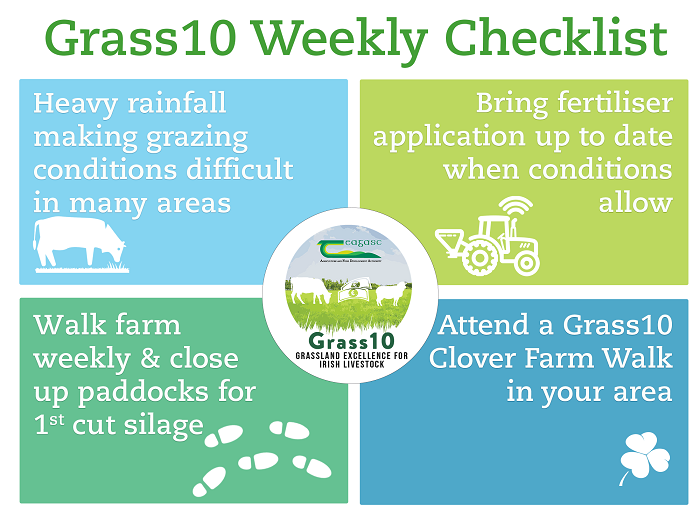13 April 2023
Grass10: Heavy rainfall making grazing conditions difficult

Most farms, particularly those on the western seaboard and in the border, midlands and west region, have received significant rainfall volumes over the past weekend, the latest Grass10 newsletter explains, while also offering advice for the week ahead.
This has hampered grazing conditions on many farms that have already received considerable rainfall over the last three or four weeks. The priority is still to get grass in every day, as every 3kg of grass in the diet results in 1L extra milk/cow and additional daily gain for drystock farms.
To aid this, the use of spur roadways, back fencing and on-off grazing is recommended to get grass in the diet. The extra work to get animals to grass is definitely worth it. With the forecast for warmer, settled conditions towards the weekend and less rainfall, the situation should improve.
Walk your farm weekly and close up paddocks for first-cut silage
- Walk the farm this week to assess covers and ground conditions. Don’t let average farm cover (AFC) drop below 600kg DM/ha;
- AFC on PastureBase Ireland has built in the past week to 840kg DM/ha due to growth rates on average of 31kg DM/ha;
- Make second rotation the priority grazing. Graze second rotation paddocks around 1,200kg DM/ha, even if not finished the first rotation to keep on top of grass quality;
- There is plenty of grass supply on farm, so when weather improves reduce/remove silage and consider reducing meal to get through more grazing area;
- It is also time to consider what grazing ground will be cut for first-cut silage. Remove this from the wedge on PastureBase Ireland and apply sufficient nitrogen, phosphorous, potassium and sulphur when weather allows.
Bring fertiliser applications up to date this week
Weather has been difficult over the week to get fertiliser up to date, so focus on getting up to date with fertiliser and slurry applications this week on both grazing and silage ground. Where necessary, include phosphorous, potassium and sulphur.
Consult your nutrient management plan, but the target is to have around 60 units/ac of nitrogen out by this week on dry paddocks and 45 units/ac of nitrogen on heavy paddocks. This figure includes slurry.
The Teagasc Grass10 and Clover150 team, along with Teagasc Grassland Researchers and the Teagasc Advisory team, are holding a series of nationwide farm walks in April to discuss the establishment, management and benefits of red and white clover. For more information on these events, click here. For more on the Grass10 Campaign, click here.
